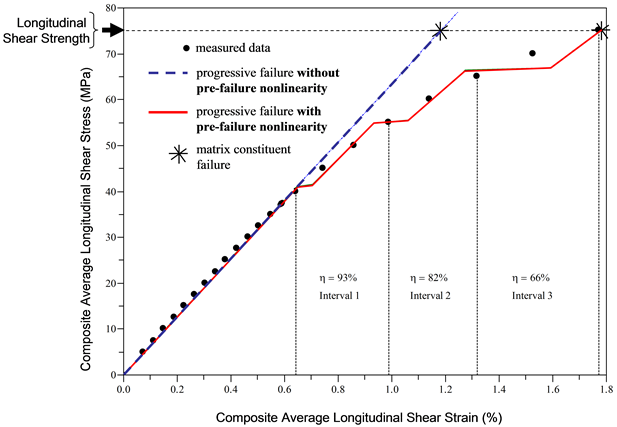Appendix A.8 - Pre-Failure Nonlinearity (PRENL)
(Not available for woven composites that use the Full Unit Cell microstructure)
The PRENL field activates or deactivates the pre-failure nonlinearity feature. A value of ON activates the pre-failure nonlinearity feature, while the default value of OFF deactivates the pre-failure nonlinearity feature.
The pre-failure nonlinearity feature accounts for the nonlinear longitudinal shear (softening) response commonly observed in fiber-reinforced composite materials prior to ultimate failure. This additional form of nonlinearity involves imposing a series of discrete reductions in the longitudinal shear stiffness of the matrix constituent material ( and
and  ) which directly results in a corresponding series of discrete reductions in the longitudinal shear stiffness of the composite material (
) which directly results in a corresponding series of discrete reductions in the longitudinal shear stiffness of the composite material ( and
and  ). Specifically, three discrete reductions are applied to unidirectional materials and six discrete reductions are applied to woven materials that use the reduced unit cell. Imposition of these discrete reductions in the longitudinal shear moduli are completed prior to matrix constituent failure, thus providing a longitudinal shear softening effect.
). Specifically, three discrete reductions are applied to unidirectional materials and six discrete reductions are applied to woven materials that use the reduced unit cell. Imposition of these discrete reductions in the longitudinal shear moduli are completed prior to matrix constituent failure, thus providing a longitudinal shear softening effect.
The plot below shows a typical measured longitudinal stress/strain curve for a unidirectional carbon/epoxy lamina. The pre-failure nonlinearity feature approximates this type of nonlinear longitudinal shear response with a four-segment, piecewise linear representation of the longitudinal shear response.

We could create a similar plot for woven composite materials. In this case, rather than three discrete reductions in the longitudinal shear stiffness, we would see six discrete reductions that result in a seven-segment piecewise linear representation of the longitudinal shear response.
For further information on the pre-failure nonlinearity feature, refer to the Theory Manual. Appendix B details the discrete values that the PFA Damage State variable can assume during a progressive failure analysis where the pre-fail nonlinearity feature is activated.